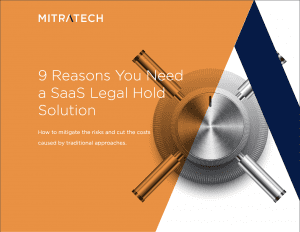3 Reasons (Among Many) for Adopting a SaaS Legal Hold Solution?
‘He who hesitates is lost,’ the adage goes. One could modify this: ‘S/he who hesitates to transform will lose – in court.’ That alone should be enough reason to replace conventional legal hold processes with SaaS legal hold software.
As we pointed out recently, a legal hold can be a frighteningly complex task, potentially involving thousands of documents and hundreds of people, dispersed across business units and borders, servers and systems. Locating and preserving the right records and data, especially when you’re managing multiple holds at the same time? That can generate risk of noncompliance and negative litigation outcomes if a legal department is still relying on manual, conventional methods to manage it all.
Legal hold software solutions help mitigate that risk and reduce the cost, labor, and potential confusion attached to the process by automating and standardizing legal holds so they’re efficient, comprehensive, and defensible. The best of these solutions are SaaS-based, and can smoothly integrate with ELM and matter management platforms as well. So there’s centralized oversight and control of every aspect of a legal department’s portfolio.
Moreover, as courts become more accustomed to the improved compliance shown by legal hold software adopters? It’s easy to predict they’ll become less and less tolerant (as courts are prone to do) of those who fall short of a SaaS-enabled level of performance.
Here are just three of the all-too-numerous reasons to adopt a SaaS legal hold solution:
 To avoid the costs and sanctions of failing to comply
To avoid the costs and sanctions of failing to comply
If a legal hold isn’t properly executed, negative outcomes can arrive on more than one front: There’s the possibility of losing the case being litigated, and of judicial sanctions being imposed for not having made a “reasonable” effort to comply.
A court may punish a party for spoliation of evidence connected to noncompliance, but penalties can extend beyond financial costs. A court may compel discovery, or enter a judgment for the opposing party.
Or it may choose to issue adverse jury instructions as a sanction: In O’Berry v. Turner, a 2016 Georgia personal injury case, a federal judge found that the defendant’s data preservation efforts had been “minimal,” and instructed the jury that they could presume the missing evidence would have been damaging to the defendant’s case.
Noteworthy examples of how failed legal hold processes impacted corporations involved in litigation?
Deleting data earned a $3MM penalty:
In 2012, when Plantronics got notice of an antitrust lawsuit against it, it informed employees to preserve relevant information, held training sessions, and issued regular reminders about proper compliance. Yet one executive still deleted over 40% of his emails and even urged others to follow suit, resulting in the loss of thousands of emails. Despite Plantronics’ efforts to preserve and then recover this data, a federal judge imposed $3 million in sanctions on the company.
How “sloppiness” slapped HarperCollins Christian:
During the course of a lawsuit against the religious publishing division of HarperCollins, a Special Master and a Magistrate Judge both found the defendant had exhibited “willfull blindness” during the hold process, was “casual and careless” and “homebrew, sluggish and sloppy,” and showed “paralysis or even purposeful sluggishness” with its “commitment to defensible collection and search [being] at best perfunctory.” Over 750,000 emails and attachments from the relevant time period hadn’t been preserved, among other materials. Among the multiple sanctions? Harper Collins Christian was precluded from offering certain evidence its defense and would be responsible for 75% of the Special Master’s fees and costs and 50% of plaintiff’s attorneys’ fees. Total penalties in this case, which originated in 2012, will probably reach into the seven figures.
 To reach the right custodians
To reach the right custodians
If you’ve managed to (generally) ascertain where the material might be you need to preserve under a legal hold, you then have to deliver proper instructions to the people who’ll be responsible for that preservation – its custodians. Here, though, we again run up against the shortfalls of a manual legal hold system.
Often, a legal department can only make informed guesses about who’s responsible for relevant ESI or physical documents. That’s almost exponentially more difficult if they’re part of a large corporation or global enterprise where in-house legal staffers have to identify potential custodians in far-flung offices.
In many cases, they will have never had prior contact with those employees or their managers, so they’re faced with untangling organizational knots to pinpoint the appropriate custodians.
Another level of difficulty presents itself when relevant data is scattered among potentially even thousands of custodians. The task of simply identifying who’s an actual eligible custodian can become a huge time-sink for a legal department, rife with rabbit holes and dead ends.
The solution? A SaaS legal hold solution that integrates cleanly with your HR and enterprise platform databases via APIs/direct connectors. These allow the software to sync directly with these databases. The benefits to your in-house legal team?
- Access to data and devices so they can do early case assessments, collect relevant take.
- The ability to suspend routine deletion tasks that could compromise key data.
- Significant acceleration in the identification phase of your hold process.
- Increased chances of targeting the right custodians straightaway and eliciting timely responses and attestation.
- It won’t require IT assistance (or only minimal involvement).
 To ensure custodian compliance
To ensure custodian compliance
Perhaps you’ve sent out a legal hold message from a member of your Legal Ops team. Then followed it up with one from an in-house lawyer. Or even, in the most urgent imaginable circumstance, from your General Counsel. Yet the response from the target custodian(s)? Non-existent.
But getting 100% compliance from every person responsible for preserving data or documents relevant to that hold? It’s absolutely imperative.
Yet sometimes, custodians simply don’t spot the notifications you send or delay responding. Or if they’re not the right people to contact in the first place (see Reason #2), they might even ignore them or skip replying because there’s plenty of other work on their plate. In that case, they’re leaving you in the dark about the fact they’re the wrong party to contact in the first place, so you squander even more vital time in follow-ups.
And as we mentioned earlier, when custodians number in the hundreds or even thousands, tracking compliance and doing proper follow-ups or escalations using traditional means becomes even more difficult. This adds a degree of inaccuracy to the process that may not bear up under scrutiny from the court or opposing counsel.
What’s the answer? It’s not A) marching to their office and camping on their doorstep, or B) throwing the problem to higher-ups (using the same labor-intensive processes, let’s remember), which may fruitlessly consume their time, too.
When custodians number in the hundreds or even thousands…
Automated reminders and escalations are a key feature of SaaS legal hold management solutions:
- They simplify and expedite the instruction and attestation process and add greater accuracy by replacing spreadsheets or other manual means of custodial tracking with automated reminders.
- Custodians receive both initial notifications and the followups you set to ensure you’re getting compliance within your timeline.
- If a recipient doesn’t comply, the issue can be automatically escalated to their superiors. But by automating the initial custodian notification process, though, this becomes more avoidable.
Need more reasons for legal hold software adoption?
Simply curious about all the reasons to move to a legal hold software solution in lieu of manual, traditional processes? Or looking for solid, proven rationales to back up a recommendation to your company’s decision-makers to subscribe to a SaaS legal hold product?
Fine more of them in our new ebook, 9 Reasons You Need a SaaS Legal Hold Solution. As anyone who’s made the move can tell you, the right time to do it isn’t soon, or ASAP, but right now.




